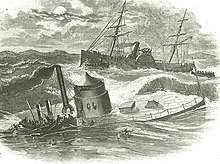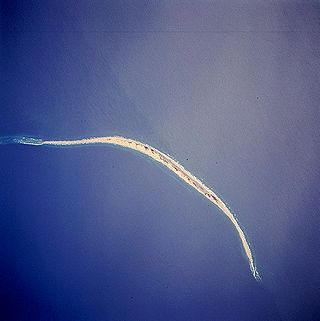
Sable Island is a small Canadian island situated 300 km (190 mi) southeast of Halifax, Nova Scotia, and about 175 km (109 mi) southeast of the closest point of mainland Nova Scotia in the North Atlantic Ocean. The island is staffed year round by three federal government staff, rising during summer months when research projects and tourism increase. Notable for its role in early Canadian history and the Sable Island horse, the island is protected and managed by Parks Canada, which must grant permission prior to any visit. Sable Island is part of District 7 of the Halifax Regional Municipality in Nova Scotia. The island is also a protected National Park Reserve and an Important Bird Area.

Cape Hatteras is a cape located at a pronounced bend in Hatteras Island, one of the barrier islands of North Carolina.

Cape Hatteras Light is a lighthouse located on Hatteras Island in the Outer Banks in the town of Buxton, North Carolina and is part of the Cape Hatteras National Seashore. The lighthouse's semi-unique pattern makes it easy to recognize and famous. It is often ranked high on lists of most beautiful, and famous lighthouses in the US.

Hatteras is an unincorporated village and census-designated place (CDP) in Dare County, North Carolina, United States, on the Outer Banks island of Hatteras, at its extreme southwestern tip. As of the 2010 census it had a population of 504. Immediately to the west of the village of Hatteras is Hatteras Inlet which separates Hatteras Island from the neighboring Ocracoke Island. North Carolina Highway 12 passes through the community linking it to Frisco to the east and Ocracoke to the west.

The Carroll A. Deering was an American five-masted commercial schooner launched in 1919 and found run aground without its crew off Cape Hatteras, North Carolina, in January 1921.
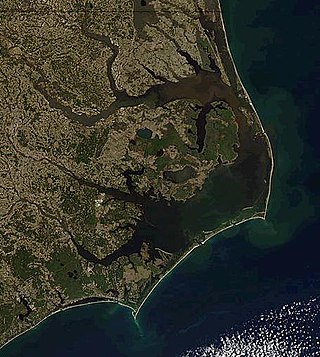
The Outer Banks are a 200 mi (320 km) string of barrier islands and spits off the coast of North Carolina and southeastern Virginia, on the east coast of the United States. They line most of the North Carolina coastline, separating Currituck Sound, Albemarle Sound, and Pamlico Sound from the Atlantic Ocean. A major tourist destination, the Outer Banks are known for their wide expanse of open beachfront and the Cape Hatteras National Seashore. The seashore and surrounding ecosystem are important biodiversity zones, including beach grasses and shrubland that help maintain the form of the land.

Theodosia Burr Alston was an American socialite and the daughter of the third U.S. Vice President, Aaron Burr, and Theodosia Bartow Prevost. Her husband, Joseph Alston, was governor of South Carolina during the War of 1812. She was lost at sea at age 29.
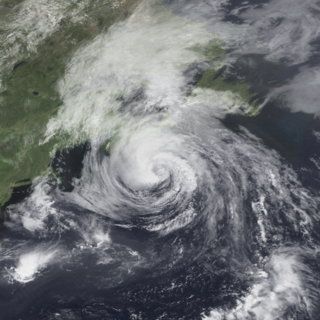
Hurricane Bertha caused minor damage in the United States, Bermuda, and Atlantic Canada in July and August 1990. The third tropical cyclone, second named storm, and first hurricane of the 1990 Atlantic hurricane season, Bertha developed from a frontal low pressure area offshore of North Carolina on July 24. Initially subtropical, it slowly acquired tropical characteristics while tracked southeast and then southwestward. By early on July 27, the cyclone was re-classified as a tropical depression. Following its transition, the depression intensified and was upgraded to Tropical Storm Bertha on July 28. The storm then curved northeastward and rapidly strengthened. Bertha became a hurricane early on July 29, though it weakened back to a tropical storm later that day. On the following day, Bertha re-intensified into a hurricane and peaked as an 80 mph (130 km/h) Category 1 hurricane on July 31.

The North Carolina Maritime Museum is a system of regional museums within the North Carolina Museum of History, which in turn part of the North Carolina Department of Natural and Cultural Resources. There are several branches of the Maritime Museum located in Beaufort, Southport and Hatteras.
Bodie Island is a long, narrow barrier peninsula that forms the northernmost portion of the Outer Banks. The land that is most commonly referred to as Bodie Island was at one time a true island, but in 1811 Roanoke Inlet, which had separated it from the Currituck Banks in the north, closed. As a result, the Currituck Banks and Bodie Island are now one contiguous peninsula, joined at the Nags Head area, where the inlet once flowed. Today, either name can be used to refer to the peninsula as a whole, but both portions colloquially retain their historical names.

The Graveyard of the Atlantic Museum is a maritime museum that focuses on the maritime history and shipwrecks of the Outer Banks of North Carolina. The museum is located in Hatteras Village, the southernmost community on Hatteras Island, North Carolina, and opened in 2002.

Hurricane How was the only tropical cyclone to make landfall on the United States in 1951. It was the eighth storm of the season, forming on September 28 in the northwest Caribbean and, after entering the Gulf of Mexico, turned eastward and became a tropical storm. The storm brought heavy rainfall to Florida, causing flooding and $2 million in damage. Tropical Storm How later became a hurricane, passing near the Outer Banks of North Carolina where it produced strong winds and high tides. A ship called the "Southern Isles" capsized off Cape Hatteras, killing 17 out of the crew of 23. Rains and high tides occurred in southeastern New England, before the hurricane moved out to sea and became extratropical.

Coquina Beach is a beach in North Carolina, US, located in the Cape Hatteras National Seashore. It is located not far from the Wright Brothers National Memorial and is off highway 12 at milepost 22, 8 miles (13 km) south of Nags Head, North Carolina. Local activities include swimming, crabbing, surf fishing, surfing, shell collecting, bird and wildlife watching and sightseeing. Coquina Beach is considered by many visitors to be among the loveliest beaches in the Outer Banks. The beach is named for the tiny Coquina clams which abound in the margin.
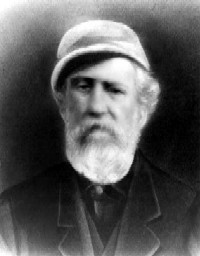
Benjamin Baxter Dailey (1844-1914) was the keeper of several lifeboat stations for the United States Life-Saving Service—one of the precursor services to the United States Coast Guard.

The Ephraim Williams was a sailing ship wrecked off the coast of Hatteras Island, North Carolina, during a late December storm, late in 1884. The rescue of the barkentine's crew by Benjamin B. Dailey and his six oarsmen of the United States Lifesaving Service was considered particularly heroic, and the rescue is celebrated to the present day.
Delight was an English sailing ship that ran aground off Sable Island, while she was on Sir Humphrey Gilbert's expedition with HMS Squirrel to Newfoundland in North America.
The 1842 Atlantic hurricane season featured several maritime catastrophes in the Gulf of Mexico and along the U.S. East Coast, and produced one of the only known tropical cyclones to directly affect the Iberian Peninsula. As the season falls outside the scope of the Atlantic hurricane database, records of most storms in 1842 are scarce, and only approximate tracks are known. The first documented storm of the season battered the coast of North Carolina in mid-July, wrecking dozens of ships and destroying homes along the Outer Banks. A little over a month later, another storm impacted the same region and caused several more shipwrecks that killed at least 12 men. This storm later doused the Mid-Atlantic states with flooding rains. In early September, a powerful storm known as "Antje's Hurricane"—named after a ship that it dismasted—tracked generally westward after first being spotted over the Leeward Islands. After yielding widespread destruction across the Bahamas, the storm traversed the Florida Straits, causing severe damage in both northern Cuba and the lower Florida Keys. Many ships and their crews were lost to the storm as it crossed the Gulf of Mexico; it finally struck northern Mexico on September 8.

Racer's hurricane was a destructive tropical cyclone that had severe effects in northeastern Mexico, the Republic of Texas, and the Gulf Coast of the United States in early October 1837. It was named after the Royal Navy ship HMS Racer, which encountered the cyclone in the northwestern Caribbean. Termed "one of the most famous and destructive hurricanes of the century" by meteorology historian David Ludlum, the storm first affected Jamaica with flooding rainfall and strong winds on September 26 and 27, before entering the Gulf of Mexico by October 1. As the hurricane struck northern Tamaulipas and southern Texas, it slowed to a crawl and turned sharply northeastward. The storm battered the Gulf Coast from Texas to the Florida Panhandle between October 3 and 7. After crossing the Southeastern United States, it emerged into the Atlantic shipping lanes off the Carolinas by October 9.
The 1827 North Carolina hurricane caused severe impacts along its track through the northeastern Caribbean Sea and up the East Coast of the United States in late August 1827. First observed over the Leeward Islands on August 17, the storm continued northwest, passing over Puerto Rico and the northern coastline of Hispaniola. It moved through the Turks and Caicos Islands and then the Bahamas by August 21 and curved northward. Although there is some discrepancy in its track, the hurricane moved ashore somewhere along the North Carolina coastline on August 25, perhaps at Category 4 intensity on the modern-day Saffir–Simpson hurricane wind scale. The cyclone emerged back into the Atlantic Ocean around Norfolk, Virginia, and grazed the New England coastline before last being observed offshore Nova Scotia on August 28. Along its track, numerous vessels were damaged, capsized, or run aground. The combination of heavy rainfall and ferocious winds caused severe crop damage, damaged or destroyed structures, and snapped and uprooted trees. Overall, the storm was responsible for more than six deaths and at least two injuries.
